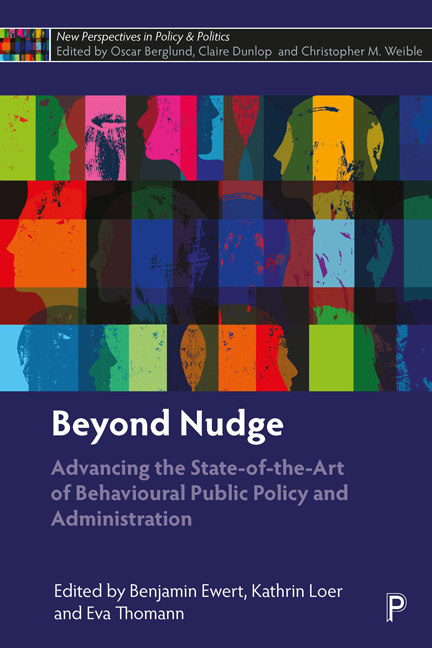Book contents
- Frontmatter
- Contents
- List of figures and tables
- Notes on contributors
- Acknowledgements
- 1 Beyond nudge: advancing the state-of-the-art of Behavioural Public Policy and Administration
- 2 Advancing behavioural public policies: in pursuit of a more comprehensive concept
- 3 A behavioural model of heuristics and biases in frontline policy implementation
- 4 Who are behavioural public policy experts and how are they organised globally?
- 5 Why nudge sometimes fails: fatalism and the problem of behaviour change
- 6 Behavioural insights teams in practice: nudge missions and methods on trial
- 7 Can street-level bureaucrats be nudged to increase effectiveness in welfare policy?
- 8 What motivates street-level bureaucrats to implement the reforms of elected politicians?
- 9 How can better monitoring, reporting and evaluation standards advance behavioural public policy?
- 10 Conclusion
- Index
9 - How can better monitoring, reporting and evaluation standards advance behavioural public policy?
Published online by Cambridge University Press: 28 March 2024
- Frontmatter
- Contents
- List of figures and tables
- Notes on contributors
- Acknowledgements
- 1 Beyond nudge: advancing the state-of-the-art of Behavioural Public Policy and Administration
- 2 Advancing behavioural public policies: in pursuit of a more comprehensive concept
- 3 A behavioural model of heuristics and biases in frontline policy implementation
- 4 Who are behavioural public policy experts and how are they organised globally?
- 5 Why nudge sometimes fails: fatalism and the problem of behaviour change
- 6 Behavioural insights teams in practice: nudge missions and methods on trial
- 7 Can street-level bureaucrats be nudged to increase effectiveness in welfare policy?
- 8 What motivates street-level bureaucrats to implement the reforms of elected politicians?
- 9 How can better monitoring, reporting and evaluation standards advance behavioural public policy?
- 10 Conclusion
- Index
Summary
Introduction
A growing interest among policy makers and researchers in the application of behavioural insight to public policy has led to the development of a wide range of behavioural public policy interventions, designed to improve the health of populations by changing behaviour of individuals, groups, communities and/ or populations, implemented at policy level and delivered via legal, fiscal, educational, regulatory, environmental or interpersonal methods. Such interventions draw on diverse fields including psychology, social science and behavioural economics, have been implemented in many contexts including health (Jepson et al, 2010), tax (Hallsworth et al, 2017) and the environment (Schultz et al, 2007; Nomura et al, 2011), and have targeted citizens, professionals, politicians and policy makers (John et al, 2019). Behavioural insights implemented by governments and other agencies have diffused across the world (Afif et al, 2018; John 2019).
With such a plethora of research activities and methods, researchers in the field need better guidelines to work out what they are reading and researching, to locate studies and to plan their own. Guides and templates provide such simplifications, and help the review of the literature too. They also satisfy a general human demand for lists and categorisations. They can be useful for researchers in helping them carry out projects and write papers so that they are clear about what they are doing. They can help locate their study in the literature and help the presentation of the study design and results. In practical fields the use of lists has become common. In medicine, for example, it is now routine for surgeons to follow elaborate checklists to avoid mistakes and to avoid leaving out essential steps or leaving items in a patient’s body. They were resisted at first as intrusions into professional judgement, but over time practitioners have got used to and value them. In a similar way, researchers are getting used to such lists, and many we review here have been going for some time. The question is less about whether to use a list or not, but which list to use. In the conclusion to this chapter, we review whether behavioural public policy researchers could use one overall reporting template for experiments that pulls in other lists.
- Type
- Chapter
- Information
- Beyond NudgeAdvancing the State-of-the-Art of Behavioural Public Policy and Administration, pp. 172 - 194Publisher: Bristol University PressPrint publication year: 2023

